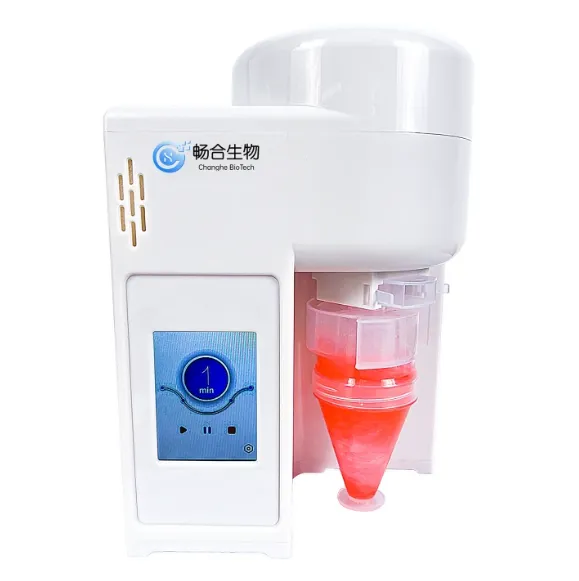
The Importance of Calibration for Bioaerosol Samplers
In the realm of environmental and biological monitoring, bioaerosol samplers play a crucial role in collecting airborne biological particles. Alongside mostradores biolóxicos and mostradores de bacterias, these devices are essential for studying air quality, disease transmission, and ecological interactions. However, to ensure the reliability and accuracy of the data they generate, regular calibration is of utmost importance.

Ensuring Data Accuracy with Bioaerosol Sampler Calibration
Calibration of bioaerosol samplers is the cornerstone of obtaining accurate data. Over time, factors such as wear and tear, environmental conditions, and component degradation can affect the performance of a mostrador de bioaerosol. Without proper calibration, the sampler may not collect particles at the correct flow rate or with the intended efficiency. This could lead to inaccurate measurements of bioaerosol concentrations, potentially resulting in misinterpretations of air quality and incorrect public health advisories. By regularly calibrating bioaerosol samplers, researchers and environmental professionals can be confident that the data they collect truly reflects the actual levels of biological particles in the air.
Maintaining Consistency in Biological Sampler Performance
Mostradores biolóxicos, which encompass a wide range of devices including bioaerosol samplers and mostradores de bacterias, need to maintain consistent performance for reliable long - term monitoring. Calibration helps in standardizing the operation of mostradores biolóxicos across different locations and time periods. For example, in a large - scale study involving multiple mostradores biolóxicos deployed in various cities, calibration ensures that all devices are operating under the same parameters. This consistency is vital for comparing data sets, identifying trends, and making valid scientific conclusions. Whether it’s tracking the spread of airborne pathogens using mostradores de bacterias or studying the distribution of pollen with bioaerosol samplers, proper calibration guarantees that the results are comparable and trustworthy.
Enhancing the Precision of Bacteria Sampler Measurements
Bacteria samplers, a specialized type of mostrador biolóxico, require meticulous calibration to accurately measure the presence and concentration of airborne bacteria. Even a slight deviation in the sampling efficiency of a mostrador de bacterias can have significant implications, especially in healthcare settings, food processing facilities, and laboratories. Calibration procedures for mostradores de bacterias typically involve checking the air intake flow rate, the collection efficiency of the sampling medium, and the integrity of the device’s components. By ensuring that mostradores de bacterias are calibrated correctly, professionals can accurately assess the risk of airborne bacterial contamination and take appropriate preventive measures to safeguard public health and safety.
The Importance of Calibration for Bioaerosol Samplers FAQS
How often should a mostrador de bioaerosol be calibrated?
The calibration frequency for bioaerosol samplers depends on several factors, such as the frequency of use, environmental conditions, and the manufacturer’s recommendations. Generally, it is advisable to calibrate bioaerosol samplers at least once a year. However, if the sampler is used frequently or in harsh environments, more frequent calibrations, perhaps every six months, may be necessary to maintain accuracy.
What are the key components to calibrate in a mostrador biolóxico?
For mostradores biolóxicos, key components to calibrate include the air flow rate mechanism, which ensures that the correct volume of air is sampled; the sampling medium holder, to guarantee proper placement and retention of the collection material; and the sealing components, to prevent air leaks that could affect sampling accuracy. Additionally, any sensors or detectors within the mostrador biolóxico should be calibrated to ensure accurate data recording.
Can improper calibration of a mostrador de bacterias lead to false results?
Yes, improper calibration of a mostrador de bacterias can definitely lead to false results. If the air intake flow rate is not calibrated correctly, the sampler may either over - or under - sample airborne bacteria, resulting in inaccurate concentration measurements. Similarly, issues with the collection efficiency of the sampling medium due to improper calibration can cause false - negative or false - positive results, which can have serious consequences for health risk assessments and contamination control strategies.
Who should perform the calibration of bioaerosol samplers?
Calibration of bioaerosol samplers should ideally be performed by trained professionals with expertise in aerosol sampling and calibration procedures. This can include in - house technicians who have received specialized training from the manufacturer or external calibration service providers. These professionals have the necessary knowledge, tools, and calibration standards to ensure that the bioaerosol samplers are calibrated accurately and in accordance with industry best practices.
What are the consequences of not calibrating biological samplers?
Not calibrating mostradores biolóxicos can lead to a host of negative consequences. The data collected may be inaccurate, rendering it useless for scientific research, environmental monitoring, or public health decision - making. In a regulatory context, failure to calibrate mostradores biolóxicos can result in non - compliance, leading to fines, penalties, or even the shutdown of operations. Moreover, uncalibrated samplers may malfunction more frequently, increasing repair costs and potentially causing delays in critical monitoring activities.
Are you in search of reliable calibration services for your bioaerosol samplers, mostradores biolóxicos, ou mostradores de bacterias? Our company specializes in providing high - quality calibration solutions tailored to meet the specific needs of your sampling devices. With a team of experienced technicians and state - of - the - art calibration equipment, we ensure that your samplers operate at peak performance, delivering accurate and consistent data. Don't compromise on the quality of your monitoring results. Contact us today to schedule calibration services or to learn more about our comprehensive range of offerings!
-
The Integration of Bio Detection with Artificial IntelligenceNovasMay.23,2025
-
The Importance of Bio Sampling in Environmental ResearchNovasMay.23,2025
-
The Advantages of Mini PCR TechnologyNovasMay.23,2025
-
How to Perform a Mycoplasma PCR TestNovasMay.23,2025
-
Choosing the Right Bacteria Detection Device for Your NeedsNovasMay.23,2025





